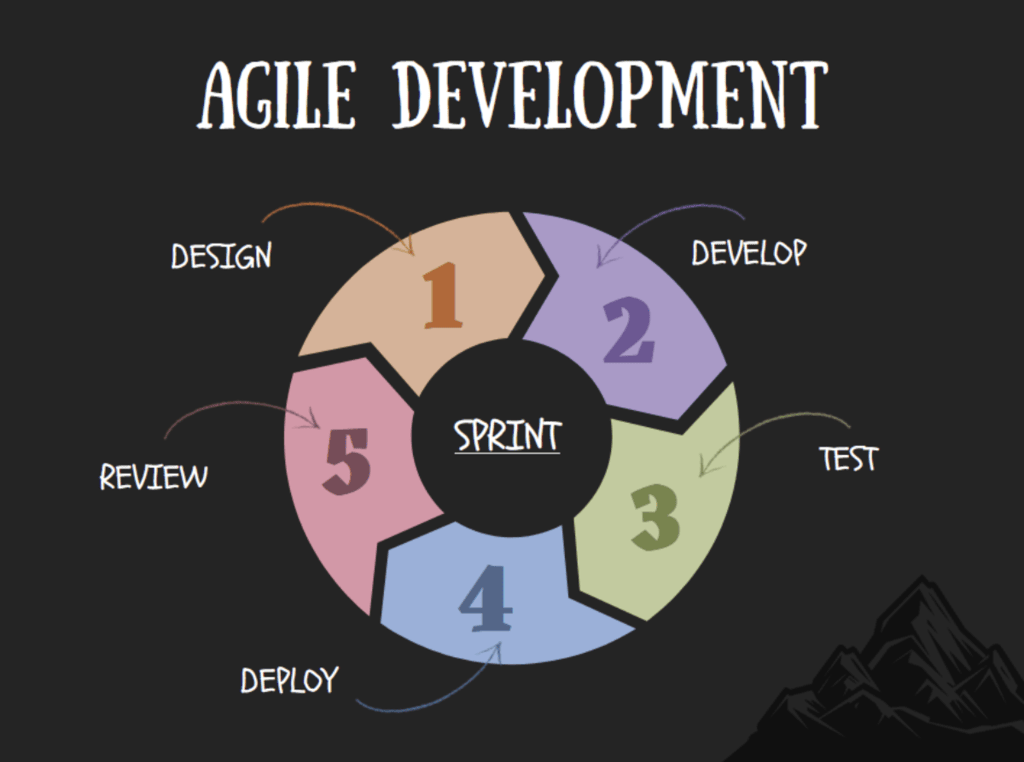Agile Development Methodology: A Proven Approach to Faster Time-to-Market
Managing development projects is hard work. Deadlines loom, bugs multiply, and teams end up coordinating more tasks than Houston on launch day. Add the customer demands for flawless software delivered at light speed, and you’re left with virtually zero margin for error.
So, how can development teams keep pace without losing their collective minds? Enter agile development. It’s a methodology that embraces iterative development and flexible project management and empowers teams to adapt quickly, collaborate efficiently, and deliver high-quality software.
Let’s take a look at how agile development can transform projects, give your dev teams an edge, and beat the clock (and the bugs).

What is Agile Development?
Agile development is not just a buzzword, it’s a lifestyle. So, what exactly is Agile development? It’s a flexible approach to software creation that focuses on collaboration, regular customer input, and rapid-fire incremental releases.
Rather than placing all hopes and dreams on a massive, final product launch, agile development teams work in short cycles called ‘sprints.’ It allows them to adapt fast to changes, fix issues on the fly, and deliver value consistently.
Contrast this with the traditional project management Waterfall model, where the step-by-step process means starting each phase only after completing the previous one. Waterfall methods for development served their purpose back in the day, but the inherent rigidity means they don’t mesh well with today’s fast-paced tech environments.
Nowadays, Agile projects enjoy a 64% success rate, compared to just 49% for Waterfall. So, why stick with outdated project management methodologies when Agile offers a much more effective way to handle the challenges of modern software development? Teams that embrace Agile respond better to change, and get to market much faster.
The Agile Manifesto – Four Values, Twelve Principles, and One Ski Trip
All the way back in 2001, a group of developers met in a ski lodge in the Utah mountains. Between caffeine fixes and code debates, they drafted what would become known as the ‘Agile Manifesto.’ It wasn’t just another corporate memo, it was a revolutionary framework on how to approach software development.
The manifesto is built around four core values:
- Individuals and Interactions over Processes and Tools: Software, while digital in nature, is built by people, not procedures. Team communication and collaboration should be prioritized as it leads to better outcomes than strictly following set protocols.
- Working Software over Comprehensive Documentation: No one ever gets excited over the thoroughness of documentation when the software doesn’t work. Documentation always has its place, but it’s the functioning software that ultimately delivers value to its users.
- Customer Collaboration over Contract Negotiation: Engaging customers throughout the entire process means the final product is far more likely to actually meet their needs. After all, it’s much easier to hit a target when the person holding it tells you exactly where they are.
- Responding to Change over Following a Plan: The only constant in the software development world is change. Being flexible (agile) enough to adjust the course based on new information is much better than sticking to a rigid plan that’s no longer relevant.
These values are supported by the twelve guiding principles that essentially boil down to advocating for early and continuous delivery, welcoming environments that change, and delivering working software frequently.
So, how do these ideals translate into your daily life as a software developer?
- Frequent Delivery: Teams adopt interactive development and work in sprints to deliver small but functional pieces of the software regularly. This keeps stakeholders engaged and allows for super-fast adjustments based on their feedback.
- Embracing Change: Teams that are truly agile aren’t thrown off by requirements that shift or new challenges. They adjust their plans and keep that momentum going.
- Collaboration is Key: Open lines of communication in the form of daily stand-ups mean that everyone knows where they stand and where they’re going.
- Sustainable Pace: A work pace that can be maintained indefinitely is far more achievable and means fewer burnout-induced meltdowns and steady progress.
- Continuous Improvement: At the end of each spring, teams hold ‘retrospectives’ to discuss what did and didn’t work, adding to a culture where learning and improvement are all part of the routine.
When agile teams live and breathe these values and principles, they create a dynamic environment where adaptability, collaboration, and customer satisfaction are turned from goals into standard operating procedures.
Iterative Development – Because Rome Wasn’t Built in a Day (But Maybe in Sprints)

We’re fairly sure you’ve heard the saying that Rome wasn’t built in a day, but if they had used sprints, who knows? Iterative development is the core of Agile Development, turning truly colossal projects into manageable, bite-sized pieces.
Instead of waiting months for a grand reveal that could potentially flop harder than your first attempt at baking a cheesecake, teams deliver smaller, functional parts of the software at regular intervals or ‘sprints.’
Think of sprints kind of like climbing Mt. Everest. If you attempt it in one go, you’re going to get tired (burnout), and you’re much more likely to fall halfway through (failed to meet expectations). You either eventually give up or deliver ‘as is.’ The prospect of having to cover the ground all over again from scratch is just too much to face.
If you break down the climb into a series of enjoyable hikes, you reach milestones faster, allow yourself to celebrate small victories, and before you know it, you’ve built something remarkable (functional software), all one sprint at a time.
Sprints are the only race where slowing down actually gets you ahead. By focusing on short development cycles of usually two to four weeks, teams can adapt faster, reduce risks, and catch bugs well before they become infestations.
Each sprint typically involves these steps:
- Planning and Design: The team huddles, decides what to feature and fix next, and then drafts a game plan before hitting the field.
- Development: Where ideas turn into reality. Developers and designers work together to build the previously agreed-upon features.
- Testing: Before unleashing the finished product, quality assurance steps in to catch any bugs or issues.
- Deployment: The figurative hitting of the big red button. The working software is deployed to users and stakeholders, and the team gets ready to pat themselves on the back for a job well done.
- Review (Retrospective): The team gathers for story time and reflects on what worked, and what was a monumental failure. They then use this information to ensure the next sprint runs even smoother.
The beauty of iterative cycles lies in their inherent flexibility. If a feature isn’t panning out, you can pivot well before it sinks the whole project. It’s a little like steering a speedboat instead of an oil tanker—adjustments are quick and don’t cause catastrophic disasters.
Agile Project Management – Herding Cats Made Easy

Whether you’re on a development team or managing one, trying to organize everyone really does feel like herding cats (sorry, but it’s true). Agile project management aims to turn the chaos that we’ve all felt when using Waterfall methodology into a little bit of harmony, and it’s made easier with these inbuilt strategies:
User stories
Forget monstrous documents that make War and Peace seem like light reading. User stories boil down features into simple and relatable narratives from the perspective of your end-users.
These keep everyone focused on delivering what your customers actually want.
Daily stand-ups
These are super quick gatherings where each team member stands (or unmutes their mic for remote workers) and shares what they did yesterday, and what they’re tackling today.
It’s a chance to even out bumps and ask for help before issues turn into firefights.
Visibility (the Art of)
Agile methodology makes use of task boards and burndown charts that put everyone’s progress on display. It’s far harder to hide behind a mountain of jargon when everyone’s to-do lists are out there for all to see. This transparency means more accountability, and dare we say, a bit of friendly competition.
In saying that, be sure not to turn the wall meetings into a shaming session for anyone lagging behind. These are there to help everyone meet their goals as a team.
Implement these Agile practices and you’ll find that keeping the team on track becomes less about herding cats and more about, well, still cats, but ones that actually listen. With the right approach, project management and Agile can be both smooth and a little fun.
DevOps and Agile – The Dynamic Duo of Faster Delivery
If Agile and DevOps formed a band, they’d be topping the charts. Seriously, these two concepts were simply made for one another. While Agile development keeps your team nimble, DevOps takes that agility and adds rocket fuel by uniting the paradoxically distant but close worlds of software development and IT operations.
For the uninitiated, DevOps is a combination of, you guessed it, Development and Operations. The aim of DevOps is to bridge the gap between software developers and IT operations at large.
It promotes a ‘culture of collaboration’ where both teams work together throughout the entire software lifecycle. The goal is to shorten development cycles, increase the frequency of deployments, deliver reliable updates, and have the added bonus of getting two teams actually talking to each other.
So, how do Agile and DevOps complement each other? Agile has its focus on interactive development, delivering small chunks of functionality through sprints. But writing code is only half the battle, getting it into the hot hands of users is the other.
DevOps steps in here with its focus on continuous integration and continuous delivery (CI/CD). It ensures that code changes flow smoothly from the dev’s keyboard into the production environment without getting lost along the way.
CI/CD pipelines automate the testing deployment process. They reduce human error and free up the team to focus on critical tasks like debating tabs vs. spaces and actually launching the software. It’s a gift that keeps on giving, and it leads to faster releases and very happy stakeholders.
Pros and Cons of Utilizing the Agile Methodology
Making the leap to Agile Development methodology is like trading a Lada in for a Ferrari. Yes, it can supercharge your projects, but only if you know how to handle the speed.
Agile Perks
Embracing Agile accelerates everything from your timelines to team collaboration. Communication improves, silos tumble down, and everyone from accounting to the IT service desk has the opportunity to contribute something.
The emphasis on continuous testing and feedback elevates the quality of products and results in more restful nights for every single team member.
Agile Pitfalls
It all sounds like smooth sailing so far, but beware, without careful execution, it’s easy to find yourself falling into the “Agilefall” trap. This is a clumsy blend of both Agile and Waterfall that combines the drawbacks of both frameworks with none of the good parts.
Company-wide resistance to change can also throw a wrench in the works. Changing to Agile requires entire departments—and, in the case of smaller businesses, the entire company—to change a lot of operating procedures.
Adopting Agile means a mindset shift, and while change really is hard for some, sticking with outdated methods is much harder in the long run.
Embracing Agility – Because Time Waits for No One
In software development, standing still is a surefire way to become obsolete. Development teams should stop viewing Agile development as just another item on a very long corporate buzzword list. It’s the best way to propel teams past deadlines and competitors alike.
Through Agile, teams can boost collaboration, increase product quality, and shrink time-to-market by turning towering projects into a series of manageable and victorious sprints.
Is your dev team ready to make the leap? If your business hasn’t made the Agile leap just yet, KMS technology is here to help. Whether it’s through testing services or collaborative solutions, we’re here to help you harness agility and stay well ahead of the curve.






